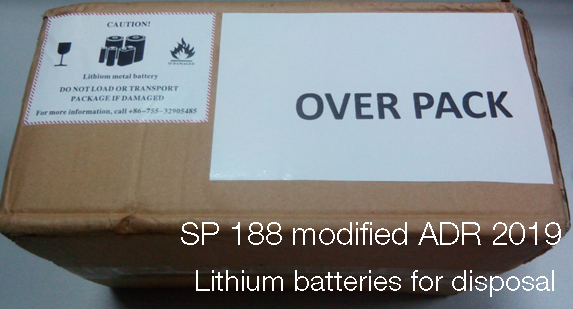
Special provisions applicable to certain articles or substances
When Column (6) of Table A of Chapter 3.2 indicates that a special provision is relevant to a substance or article, the meaning and requirements of that special provision are as set forth below. Where a special provision includes a requirement for package marking, the provisions of 5.2.1.2 (a) and (b) shall be met.
If the required mark is in the form of specific wording indicated in quotation marks, such as “LITHIUM BATTERIES FOR DISPOSAL”, the size of the mark shall be at least 12 mm, unless otherwise indicated in the special provision or elsewhere in ADR.
188 Cells and batteries offered for carriage are not subject to other provisions of ADR if they meet the following:
(a) For a lithium metal or lithium alloy cell, the lithium content is not more than 1 g, and for a lithium ion cell, the Watt-hour rating is not more than 20 Wh;
(b) For a lithium metal or lithium alloy battery the aggregate lithium content is not more than 2 g, and for a lithium ion battery, the Watt-hour rating is not more than 100 Wh.
Lithium ion batteries subject to this provision shall be marked with the Watt-hour rating on the outside case, except those manufactured before 1 January 2009;
NOTE: When lithium batteries in conformity with 2.2.9.1.7 (f) are carried in accordance with this special provision, the total lithium content of all lithium metal cells contained in the battery shall not exceed 1.5 g and the total capacity of all lithium ion cells contained in the battery shall not exceed 10 Wh (see special provision 387).
(c) Each cell or battery meets the provisions of 2.2.9.1.7 (a), (e), (f) if applicable and (g);
(d) Cells and batteries, except when installed in equipment, shall be packed in inner packagings that completely enclose the cell or battery. Cells and batteries shall be protected so as to prevent short circuits. This includes protection against contact with electrically conductive material within the same packaging that could lead to a short circuit. The inner packagings shall be packed in strong outer packagings which conform to the provisions of 4.1.1.1, 4.1.1.2 and 4.1.1.5;
(e) Cells and batteries when installed in equipment shall be protected from damage and short circuit, and the equipment shall be equipped with an effective means of preventing accidental activation. This requirement does not apply to devices which are intentionally active in carriage (radio frequency identification (RFID) transmitters, watches, sensors, etc.) and which are not capable of generating a dangerous evolution of heat. When batteries are installed in equipment, the equipment shall be packed in strong outer packagings constructed of suitable material of adequate strength and design in relation to the packaging’s capacity and its intended use unless the battery is afforded equivalent protection by the equipment in which it is contained;
(f) Each package shall be marked with the appropriate lithium battery mark, as illustrated in 5.2.1.9;
This requirement does not apply to:
(i) Packages containing only button cell batteries installed in equipment (including circuit boards); and
(ii) Packages containing no more than four cells or two batteries installed in equipment, where there are not more than two packages in the consignment;
“When packages are placed in an overpack, the lithium battery mark shall either be clearly visible or be reproduced on the outside of the overpack and the overpack shall be marked with the word “OVERPACK”. The lettering of the “OVERPACK” mark shall be at least 12 mm high.
“NOTE: Packages containing lithium batteries packed in conformity with the provisions of Part 4, Chapter 11, packing instructions 965 or 968, Section IB of the ICAO Technical Instructions that bear the mark as shown in 5.2.1.9 (lithium battery mark) and the label shown in 5.2.2.2.2, model No. 9A shall be deemed to meet the provisions of this special provision.”
(g) Except when batteries are installed in equipment, each package shall be capable of withstanding a 1.2 m drop test in any orientation without damage to cells or batteries contained therein, without shifting of the contents so as to allow battery to battery (or cell to cell) contact and without release of contents; and
(h) Except when batteries are installed in or packed with equipment, packages shall not exceed 30 kg gross mass. As used in this special provision “equipment” means apparatus for which the lithium cells or batteries will provide electrical power for its operation.”.
As used above and elsewhere in ADR, “lithium content” means the mass of lithium in the anode of a lithium metal or lithium alloy cell.
Separate entries exist for lithium metal batteries and lithium ion batteries to facilitate the carriage of these batteries for specific modes of carriage and to enable the application of different emergency response actions.
A single cell battery as defined in Part III, sub-section 38.3.2.3 of the Manual of Tests and Criteria is considered a “cell” and shall be carried according to the requirements for “cells” for the purpose of this special provision.

